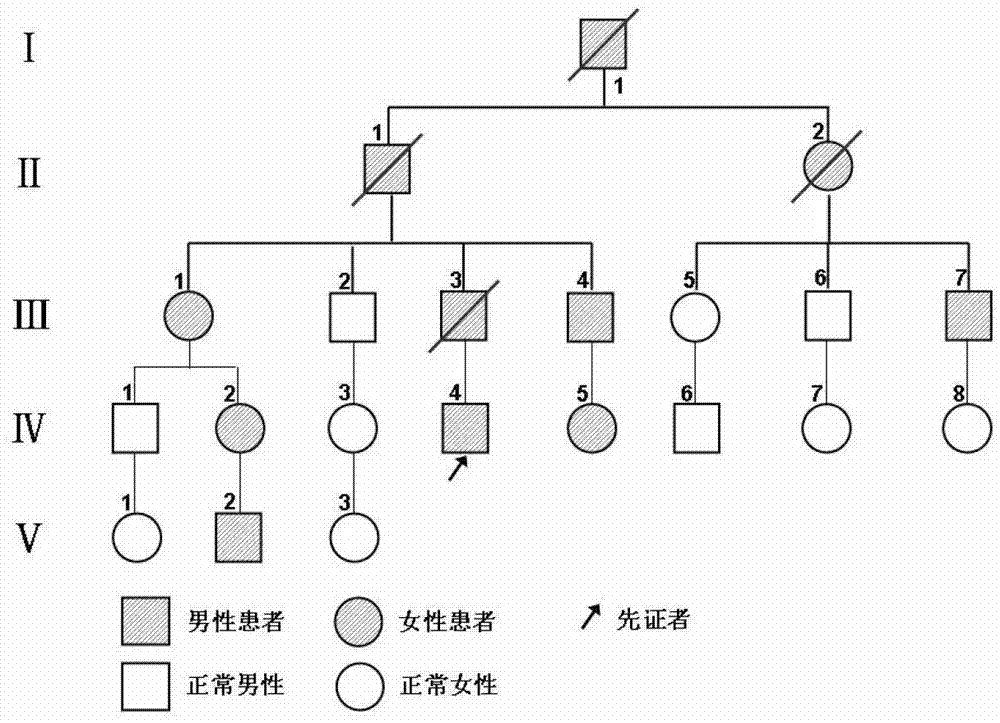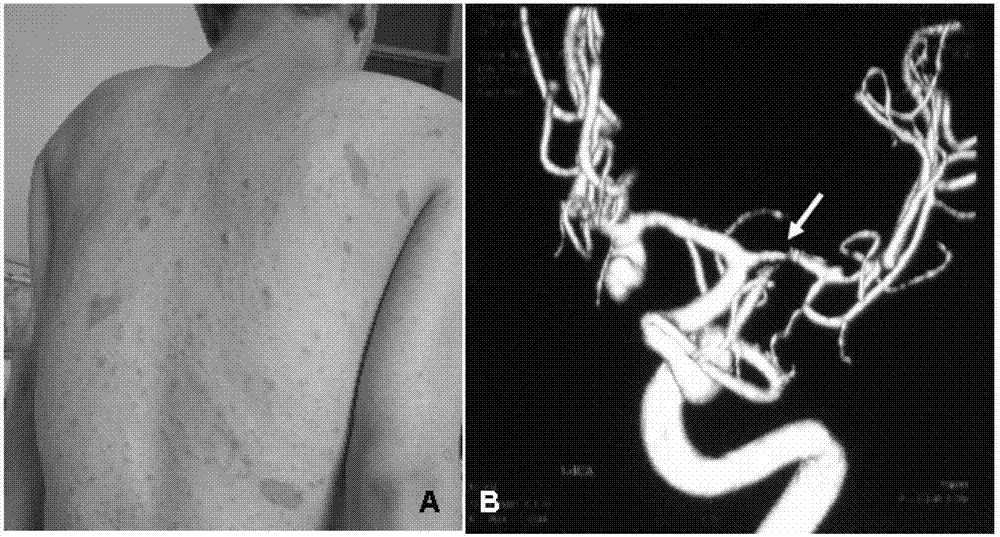I type neurofibroma NF1 gene mutation nucleotide sequence related to cerebrovascular stenosis and application thereof
A technology for stenosis of cerebral blood vessels and neurofibromas, applied in the field of disease diagnosis, can solve the problems of few and weak inhibition of RAS-signaling pathway, etc.
- Summary
- Abstract
- Description
- Claims
- Application Information
AI Technical Summary
Problems solved by technology
Method used
Image
Examples
Embodiment 1
[0040] Example 1 Family analysis of neurofibromatosis type Ⅰ complicated with cerebrovascular stenosis
[0041] 1 Objects and Methods
[0042] 1.1 Object
[0043] Proband (Ⅳ4, figure 1 ), male, 24 years old, 8 years ago due to a sudden increase in blood pressure and surgery for a large neurofibroma on the head, the physical examination found that the blood pressure was 180 / 100mmHg, and recently there was severe headache, nausea and vomiting with vision again due to no special trigger Ambiguity admission, blood pressure 210 / 135mmHg. Diagnosed with renovascular hypertension and neurofibroma, he was admitted to hospital. Ultrasound results after admission revealed renal artery stenosis and left MCA stenosis. In addition, the patient was of normal intelligence and had multiple intrarenal aneurysms (AN) and anterior communicating artery (ACOA) aneurysms. Other system checks were normal. There were multiple round or oval light brown spots with a diameter of about 1-2 cm on the...
Embodiment 2D
[0059] Example 2 DHPLC screening of Nf1 gene mutation in type Ⅰ neurofibromatosis family with cerebrovascular stenosis
[0060] Nf1 gene mutation in patients with variable and simple cerebral vascular stenosis
[0061] 1 Objects and methods
[0062] 1.1 Research object of Nf1 whole gene mutation screening
[0063] Nf1 full gene screening includes 13 cases of blood samples collected from families: see figure 1 6 patients with vascular disease (Ⅲ-4,Ⅲ-7,Ⅳ-2,Ⅳ-4,Ⅳ-5,Ⅴ-2; detection number: 1-6) and no neurofibromatosis in the family 7 cases (Ⅲ-2, Ⅲ-5, Ⅲ-6, Ⅳ-1, Ⅳ-3, Ⅳ-7, Ⅳ-8; detection number: 13-18) and 5 cases without other risk factors or underlying diseases Patients with simple cerebral vascular stenosis (test number 8-12).
[0064] Table 118 objects of Nf1 gene mutation screening
[0065]
[0066] 1.2 Denaturing high performance liquid chromatography (DHPLC), the flow chart is as follows Figure 4 shown.
[0067] 1.2.1 Sample preparation and pretreatment
[0068] DH...
Embodiment 3
[0090] Example 3 A kit for diagnosing cerebrovascular stenosis and its application
[0091] 1. Preparation of the kit:
[0092] 1. PCR primer design and synthesis (5pmol / μL):
[0093] 5'-GAAGGAAGTTAGAAGTTTGTGACA-3' (Primer 1)
[0094] 5'-CAATCGTATCCTTACCAGC CAT-3' (Primer 2)
[0095] 2. PCR reaction solution: double distilled water, 10×PCR buffer (TaKaRa), 25mM Mg 2+ , 10 mM dNTPs.
[0096] 3. Enzyme: Taq DNA polymerase (TaKaRa).
[0097] 2. Application in the diagnosis of cerebral vascular stenosis
[0098] 1. Collect blood samples and extract genomic DNA;
[0099] 2. Using the designed primers, carry out PCR amplification according to the following procedure:
[0100] 2.1. Preparation of PCR reaction system:
[0101]
[0102]
[0103] 2.2. Setting of PCR reaction conditions, that is, setting a program on the PCR thermal cycler, and performing amplification according to the conditions set by the program.
[0104] (1) Pre-denaturation at 94°C for 5 minutes; (2) ...
PUM
 Login to View More
Login to View More Abstract
Description
Claims
Application Information
 Login to View More
Login to View More - R&D
- Intellectual Property
- Life Sciences
- Materials
- Tech Scout
- Unparalleled Data Quality
- Higher Quality Content
- 60% Fewer Hallucinations
Browse by: Latest US Patents, China's latest patents, Technical Efficacy Thesaurus, Application Domain, Technology Topic, Popular Technical Reports.
© 2025 PatSnap. All rights reserved.Legal|Privacy policy|Modern Slavery Act Transparency Statement|Sitemap|About US| Contact US: help@patsnap.com



